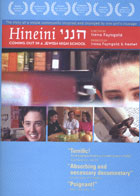
Hineini: Coming Out in a Jewish High School 2008
Distributed by Keshet, 284 Amory Street, Jamaica Plain, MA 02130; 617-524-9227
Produced by Idit Klein, Irena Fayngold
Directed by Irena Fayngold
DVD, color, 60 min.
Sr. High - Adult
Gay and Lesbian Studies, Jewish Studies, Women's Studies, Education
Date Entered: 11/03/2009
Reviewed by Maureen Puffer-Rothenberg, Valdosta State University, Valdosta, GAIn 2000 Shulamit Izen was a junior at Boston’s Gann Academy (at the time New Jewish High School of Greater Boston or, affectionately, “New Jew”). Izen wished to explore her Jewish faith more deeply, but had begun to identify herself as a lesbian; traditional Judaism forbids homosexuality and she saw no gays among her peers or teachers. Izen decided to advocate for her school to form a Gay-Straight Alliance (GSA) that would encourage greater openness and create a safe environment for gay teens at New Jew to explore their identities and who they were in relation to their faith. Hineini (Hebrew for “Here I am”) follows Izen as she learns about activism and approaches students, teachers and the school’s headmaster with her personal story and hope for a GSA. Although pluralistic, (accepting students from a wide spectrum of Jewish practice) Gann’s position was conservative and initially Izen found little support. However, her activism led to a school assembly discussion of sexuality and Judaism, a few students and teachers coming out, and eventually the formation of a GSA (although only as a “support group”).
Izen’s involvement with Keshet in high school led to much of her story being filmed as it happened; footage from Gann’s hallways, classrooms and assemblies give Hineini a very immediate feel. The film incorporates candid, articulate and affecting interviews with Izen, students who supported her efforts or felt able to come out as a result, and gay teachers on their own concerns about coming out at Gann. A couple of cautious school officials explain the need to support the GSA, but not pressure students who believed Jewish doctrine prohibited homosexuality.
The DVD provides chapter selection. Extras include a follow-up interview with Izen, comments from students after the Beit Midrash; mini-features on a student who chose not to come out at Gann and on the GSA four years after Izen’s graduation (no one at the school is openly gay); interviews with producer Idit Klein, director Irena Fayngold, and singer/songwriter Catie Curtis.
In the extra interview Izen, then in her first year at rabbinical school, describes her activism as having a more “one-on-one” and educational focus, and suggests that she no longer identifies as a lesbian: “I just got to the point where love didn’t depend on gender, and I just started to see sexuality as something that was really fluid, and as I was growing and changing, clearly my sexuality would grow and change as well.” She notes that her personal shift has been used as an argument against GLBT activism and reiterates the need for affirmation of the individual, wherever he or she may be, and on whatever spectrum.
Izen’s personality is infectious and her personal struggle to find a place within a religious tradition that largely rejects homosexuality will resonate with people facing the same issues or working towards consensus within religious organizations. Teachers and students in Hineini provide thoughtful and well-expressed insight into that situation from the perspective of gays who must assess the risks of coming out.
The film is recommended for GLBT studies and Jewish studies programs considering pluralistic views of Jewish practice and belief. It may also be useful to educators considering GLBT issues in adolescence.